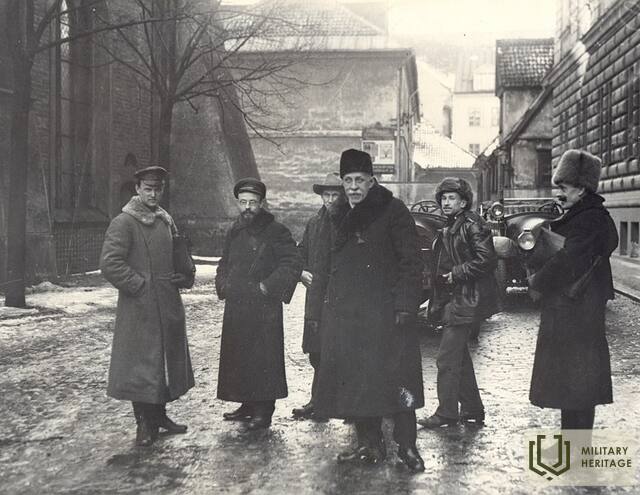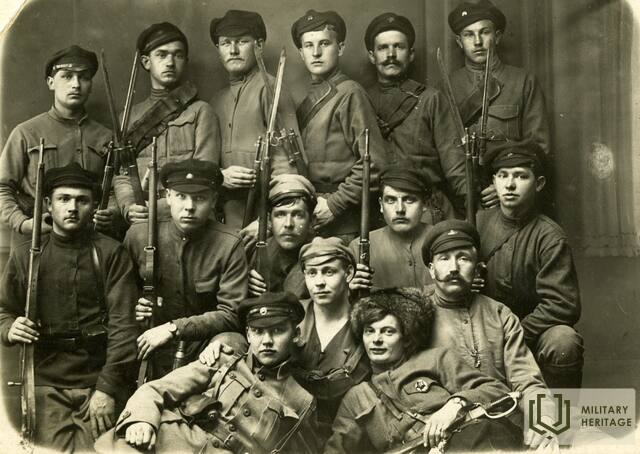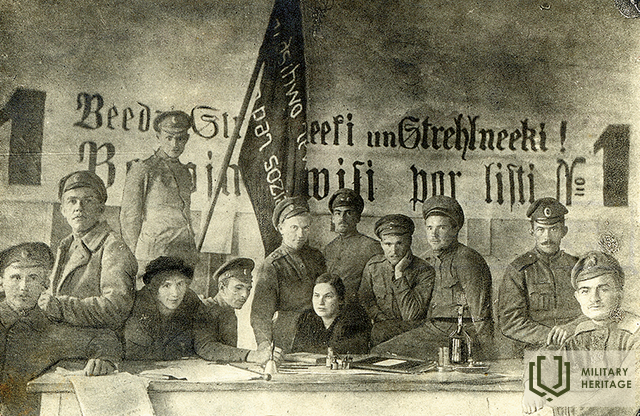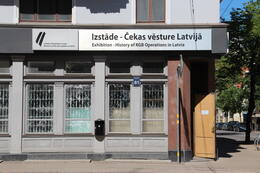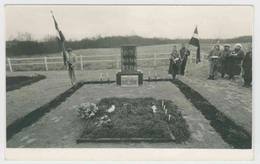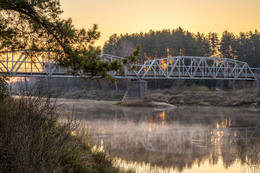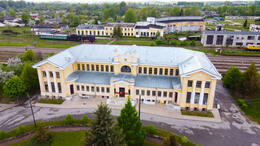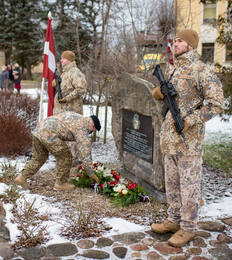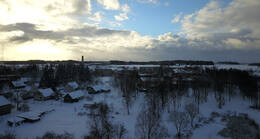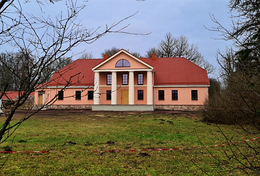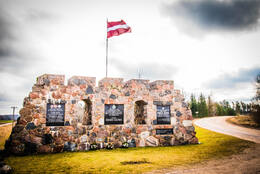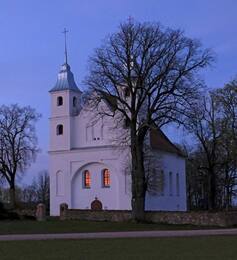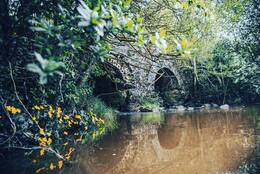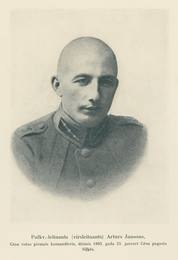Bolsheviks I World War I, I Wars of Independence
The Bigots were the radical wing of the Russian Social Democratic Workers' Party, which won a majority at the party congress in 1912 under the leadership of Vladimir Ulyanov (Lenin) and split from the party, forming the Russian Social Democratic Workers' Party (Bolsheviks). Since then, the term "Bigots" has also been used in contrast to the "minorities" or minority.
The bigots differed from the smallots both in ideological and party organizational aspects. The bigots believed that the party should be organized as a centralized fighting organization. When recruiting members, the class principle had to be strictly observed. Party members had to observe discipline, strictly obeying the decisions of the party leadership – the Central Committee. The basic structure of the party was to be formed by a relatively small group of professional revolutionaries. V. Lenin believed that the working class was not capable of independently developing socialist demands.
The grandees believed that socialism could not be achieved through evolutionary (gradual reforms) but through violent revolution and the dictatorship of the proletariat as a transitional regime from capitalism to socialism. The grandees strongly opposed cooperation with representatives of the citizenry (bourgeoisie), allowing it only in exceptional cases. The grandees rejected parliamentary democracy in principle, believing that it served the interests of the bourgeois class. They campaigned for class representation of the working people (proletariat) as opposed to national representation.
On November 7, 1917, the Bolsheviks staged a coup in the Russian capital Petrograd (modern-day Saint Petersburg), overthrowing the Provisional Government led by Alexander Kerensky and establishing a Soviet government led by V. Lenin. In the part of Latvia controlled by the Bolsheviks, power gradually came to the fore in late 1917, when the Executive Committee of the Latvian Soviet of Workers', Soldiers' and Landless Deputies, or Iskolats (an abbreviated translation of the name in Russian), took over. The new government began radical political and social reforms, introducing strict censorship.
The Soviet rule in the unoccupied part of Latvia did not last long - it lasted only a few months. When Germany resumed hostilities on the Eastern Front and occupied the entire territory of Latvia by the end of February 1918, the Bolshevik regime in Vidzeme and Latgale was destroyed. The Bolsheviks and the most loyal part of the riflemen fled to Russia.
During these few months, part of the Latvian population was able to get to know the Bolshevik regime in action directly. The activities of the Iskolat revealed several trends that were fully manifested a year later after the Bolsheviks returned. These were: the undemocratic nature of the regime, concentrating power in the hands of a narrow circle of party workers; the liquidation of democratically elected institutions and a crackdown on freedom of speech; the implementation of the principle of class struggle, which entailed repression against entire groups of society; economic reforms, which were manifested in the partial nationalization of enterprises, the confiscation of estates and the course set for the nationalization of all property and land.
Considering the implementation of communism as its goal, the Bolshevik Party renamed itself the Russian Communist (Bolshevik) Party after the 1917 coup and retained this name until 1925. From 1925 to 1952, the party's name was the "All-Union Communist (Bolshevik) Party", while from 1952 to 1991, its name was the "Communist Party of the Soviet Union". In 1991, the party was liquidated in the Russian Federation.
More information sources
1. Latvian libertarians. Published on the portal ir.lv, 03.01.2018. Available: https://ir.lv/2018/01/03/latviesu-lielineki/ [accessed: 06.05.2021.].
2. Šiliņš J. "Lielineki". National Encyclopedia. Available: https://enciklopedija.lv/skirklis/88272-lielineki [accessed 06.05.2021.].
3. Šiliņš J. Doctoral thesis “Military and political development of Soviet Latvia (December 1918 – June 1919)”, 2012. Available: https://dspace.lu.lv/dspace/handle/7/4674 [accessed: 06.05.2021].
4. Blizzard of Souls. Digital Museum. Available: https://www.dveseluputenis.lv/lv/laika-skala/notikums/85/ziemassvetku-kauju-sakums/ [accessed: 06.05.2021.].
Related timeline
Related objects
Exhibition in the KGB Building "History of KGB Operations in Latvia"
The former USSR State Security Committee (commonly known as Cheka) building is open for visitors. Here chekists imprisoned, interrogated and murdered Latvian citizens who were considered opponents by the occupation regime. There is also an exhibit from the Latvian Occupation Museum on the activities of Cheka in Latvia. Guided tours of the prison cells, corridors, basement and courtyard are available. The house was built in 1911 and it is one of the most beautiful buildings in Riga. Called the ‘Corner House’ by the people, it was the scariest symbol of the Soviet occupation regime in Latvia, and also one of the pillars of power of the USSR. Cheka operated from the Corner House during the occupation from 1940 to 1941 and then again from 1945 to 1991. Tens of thousands of Latvians were affected by direct political persecution. The fight against enemies of Soviet rule continued also after World War II. Cheka’s approach towards its operation slightly changed after Stalin’s death. Physical torture was replaced by psychological terror. The majority of Cheka agents were Latvians (52%). Russians were the second largest group – 23.7%. 60.3% of the agents were not members of the Communist Party. 26.9% of the agents had higher education. The system was designed in a way to involve local people and thus have greater control over the society. Staff documents and service records are located in Russia. And these materials have not been made available to Latvian authorities and researchers.
Memorial stone to the green partisans
Located in Ērgļi on the corner of Parka and Saules streets near the railway viaduct.
On May 23, 1919, the Green Partisans attacked a column of Bolshevik carters in the center of Ērgļi. The battle lasted two hours, and the Partisans captured 78 horses and many carts with rifles and other goods. Four Partisans died in the battle, and one was wounded. In total, 61 men fought in the ranks of the Partisans in the region, of whom six died.
On May 21, 1939, a memorial stone was erected in the village of Ērgļi by the 121st Ērgļi Small Regiment at the site where the Green partisans Jānis Andriksons, Andrejs Bumbers, Kārlis Baņģieris and Jānis Gūts fell on May 23, 1919.
During the Soviet occupation, the memorial at the intersection of Parka and Saules streets was demolished. It was restored and reinstalled on April 22, 1989.
Iron bridge over the Gauja River in Valmiera
Located in Valmiera, near the Ģīme nature trail on Leona Paegles Street.
The steel-framed iron bridge over the Gauja River was built in 1911. It connected the 114 km long route Ainaži-Valmiera-Smiltene, which was last completed in 1971.
After the liberation of Riga on May 22, 1919, parts of the Soviet Latvian army retreated along the entire front without offering any serious resistance. On May 26, the Estonian National Army and the Northern Latvian Brigade led by Colonel Jorgis Zemitāns occupied Valmiera. “The bigwigs blew up the railway bridge at around six o’clock in the afternoon. At 7:50 they also set fire to both wooden bridges. This did not prevent Estonian troops from entering the city from the Valmiera Manor in the evening of the same day* [..]”
Today, the iron bridge is a favorite place for recreation and walking and a section of the "Green Railway" bicycle route.
* The first to arrive was a cadet company of the 6th Estonian Infantry Regiment, accompanied by several armored vehicles.
Memorial stele to the Cavaliers of the Lāčplēsis War Order
Located next to the Sacred Heart of Jesus Roman Catholic Church in Viļaka.
A memorial stele for the cavaliers of the Lāčplēsis War Order in Viļaka municipality was unveiled on November 11, 2017. The fates of 28 cavaliers of the Lāčplēsis War Order are linked to the name of Viļaka municipality.
The granite stele was created as part of the project “Remember Lāčplēšis” dedicated to the centenary of the state of Latvia. In honor of the soldiers who fell in the Latvian War of Independence, memorial stele of a uniform model will be installed throughout Latvia. The initiator of the project is the Youth Guard and Information Center.
Five knights of the Lāčplēsis War Order, whose names are engraved on the memorial stele, lived in the territory of the present-day Viļaka district after the end of the War of Independence:
– Jānis Kuļšs was a young farmer in Apsīši, Šķilbēni parish,
– Aleksejs Ľubimovs (Lavrentjevs) lived on the Fortepjanova farm in Šķilbēni parish, later in Viļakas,
– Teodors Mende managed the farm assigned to him and was a forester in the village of Katleši, Žīguri parish,
– Eduards Tenisons lived at the Vecumu station, later lived in the village of Čabatrova and worked at the “Viļaka” post office,
– Jānis Burmeistars lived in Šķilbēni parish for some time after 1928.
The Brothers' Cemetery in Viļaka district is the resting place of 45 soldiers who gave their lives defending Latvia from the Bolsheviks in 1920. January 9 was the day when the attacks began in Northern Latgale, and despite the difficult weather conditions at the time, Viļaka was liberated on the same day.
During the battles for the liberation of Latgale in the Viļaka region, Estonian soldiers fought shoulder to shoulder with Latvian army soldiers and partisans against the Red Army. Many of them gave their lives for a free Latvia.
Gulbene Railway Station
The Gulbene Railway Station is located in the city of Gulbene. During World War I, in 1916 to 1917, the narrow-gauge railway line to Pļaviņas was reconstructed to 1,524 mm width to ensure that it can serve as a connection to the Rīga-Daugavpils line. In addition, a railway line to Ieriķi and to Sita was constructed, thereby establishing a connection with Pytalovo. As a result, Gulbene became a railway hub. The current station building by architect Pēteris Feders was constructed in 1926. During the War of Independence, on 31 May 1919, when Gulbene was liberated from the Bolsheviks, the 1st (4th) Valmiera Infantry Regiment collected a significant number of war trophies here. On 14 June 1941, both civilians and Latvian Army officers arrested in the Litene Summer Camp were deported from the Gulbene Railway Station. As a key hub, it was bombed in the spring of 1944. After the war, it was restored to its original form. An educational and interactive centre named ‘Railway and Steam’ was opened in 2018. Next to the Gulbene station is the company SIA Gulbenes – Alūksnes bānītis, which offers interactive lessons and tours. Visitors have access to the station building and platform, a memorial plaque and a monument to the repressed ones by sculptor Indulis Ranka.
Battle of Skrunda Memorial and Flag Day
The Skrunda Battle Memorial is located in the centre of Skrunda, in Oskaras Kalpaka Park near the Skrunda Culture House, at the intersection of Kuldīgas and Liepājas Streets. In 2005, a stone was erected at the memorial commemorating the battle of 29 January 1919, when the battalion commanded by Oskars Kalpaks, together with the German and Russian units of the Landeswehr, liberated Skrunda from the Bolsheviks. The tradition of Flag Day has been maintained since 2004, commemorating the first town liberated from the Bolsheviks and its liberators, who raised the Latvian flag at the Skrunda church on 29 January 1919.
During the first months of the War of Independence, the Latvian Provisional Government, under pressure from the Bolsheviks, was rapidly losing territory. On 22 January 1919, the Bolsheviks captured Skrunda. A week later, in the early hours of 29 January, the offensive to recapture Skrunda began. The Latvian Separate Battalion under Lieutenant Colonel Oskars Kalpaks was to attack along the Rudbāržu-Skrunda highway and drive the Bolsheviks out of Skrunda. This would be followed by a flank attack by German units with the task of destroying the advancing enemy, while the Russian company would attack between the Latvian and German units, using the Skrunda church as a landmark. The attack was also supported by a German artillery battery. On the day of the attack, the frost was 15 degrees, the sun shone brightly, the Kalpaks had to cross a clear field, and the Bolsheviks were sheltering in the stone buildings of the manor. The Bolsheviks opened fire when the chain of attackers was about 300 metres away, a two-way firefight broke out, and the soldiers under Oskars Kalpaks' command advanced in a rapid advance, forcing the enemy to cease fire and retreat across the Venta. After about 3 hours of fighting, Skrunda was captured at about 9am, with the Latvian Separate Battalion having only 2 wounded.
The Battle of Skrunda was of great importance for the morale of the Latvian Provisional Government's armed Spek soldiers, as it was in fact the first significant victory in the battles against the Bolsheviks. Moreover, the commander himself, Oskars Kalpaks, showed particular courage in the battle, encouraging the soldiers by his example not to be afraid.
Jaunmuiža and the 1st Latvian Separate Battalion
Nowadays Jaunmuiža, formerly Jaunāmuiža, is a populated place in Kuldīga Municipality and is located on the road Skrunda - Ezere, 7 kilometres. The settlement was established on the site of the former half-manor house of Jaunā manor (Neuhof).
On 3 March 1919, an intense battle took place for this place between units of the 1st Latvian Separate Battalion led by Colonel Oskars Kalpaks and units of the 2nd Soviet Latvian Rifle Regiment.
On 3 March 1919, Operation Tauwetter (Thaw), the liberation of Courland, began, in which the VI Reserve Corps of the German Army, with the Landeswehr and its 1st Latvian Battalion, launched an offensive across the front with the intention of pushing the Bolshevik units back to Lielupe. In the early morning of 3 March, units of the 1st Latvian Separate Battalion - Cēsis Company, Student Company and Cavalry Division, reinforced by the artillery battery of German Hauptmann Müller, crossed the Venta at Lėnai and attacked the Jaunai Manor, defended by the 2nd Battalion of the 2nd Soviet Latvian Rifle Regiment. During the several-hour-long battle, gradually occupying the houses in the vicinity of Jaunā muiza, Kalpaka's commanded units reached Jaunā muiza and intercepted the Skrunda-Pampali highway, interrupting the enemy's movement and pushing the enemy eastwards. In Jaunāmuiža the battalion received stationery and ammunition as trophies. Taking up positions in nearby houses the battalion fortified itself. On 5 March the Bolshevik counter-attack began, which was stopped by the evening. On 6 March the battalion resumed the attack, taking the Skrunda school and advancing towards the Airite - Aizupji area.
Lēnu Manor
The manor castle is located in the village of Lēnu, by the Venta River. The castle is currently privately owned and can therefore only be seen from a distance.
The manor house was used as a support point by the 1st Latvian Separate Battalion from the end of January to 3 March 1919. The Latvian Separate Battalion had to liberate the surroundings of Leni Manor in order to be able to cross the river opposite Jaunmuiža.
The manor belonged to Baron Friedrich von Firks, who also owned the Rudbāržzi and Sieksate manors. The manor house was built in the 19th century. For the Baron, the castle of Lēnu served mainly as a place for hunting and weekend relaxation.
From 1927 to 1937 the castle was a school, and during the Soviet occupation it was a collective farm woodshop. In 1965, a community centre was opened. The ensemble of buildings has suffered many alterations and the park has not been preserved. Several outbuildings have survived.
Memorial to the 1st Latvian Separate Battalion in Lėnai and relocation site on the Venta
The monument is located in Lēņi, at a road crossroads near Lēņi Manor.
The monument was unveiled on 8 November 2007. It was designed by sculptor Maija Engele. The author and financier of the monument is Jānis Blūms, whose father, Lieutenant Paulis Blūms, 1st Lieutenant of the 1st Separate Latvian Battalion Cavalry Division, organised and led the river crossing on 3 March 1919 with the help of 10 men.
Every year on 3 March, young guards, servicemen and other interested persons gather here for a commemorative event in honour of the 1st Latvian Separate Battalion.
Holy Trinity Roman Catholic Church in Lēni
The church is located in the village of Lēnu, Nīkrāce parish, Skrunda municipality, on the Skrunda - Embute road.
The Venta River is located near the church, the banks of which were guarded by soldiers of the 1st Separate Latvian Battalion in February 1919. As the battalion's numbers did not allow for a continuous front line, the front was guarded by sentry posts. One of them was also located on the bank of the river near the church. The church towers were useful for surveillance of the surrounding area and the other side of the river.
Battle at Skrunda school
Skrunda School is located in Pumpuri, at km 3 of the Skrunda - Ezeres road. The school is privately owned and can therefore be viewed from a distance.
In January and March 1919, the 1st Latvian Separate Battalion fought with units of the 2nd Latvian Rifle Regiment of Soviet Latvia near the school.
The battle near Skrunda School took place on 22 January 1919. In the face of the retreating Bolshevik superiority, German and Latvian units positioned themselves on the western bank of the Venta, while Bolshevik forces gathered in Saldus in preparation for a wider operation, at the same time sending some of their forces in the direction of Skrunda. In order to seize the initiative and try to defeat the Bolshevik forces piecemeal, on 22 January the Cēsis Company of the 1st Latvian Separate Battalion, reinforced by 15 soldiers of the Officers' Company and the German Raden Company in the Skrunda sector of the front, had to attack towards Saldus. The Skrunda School was designated as the assembly point for both companies. However, during the preparatory phase of the attack, both companies were surprised by a Bolshevik attack, which forced the German and Latvian units to retreat to Rudbārži.
The second clash at Skrunda School took place on 6 March 1919, when the Cēsis and Student Companies of the battalion commanded by Colonel Oskars Kalpaks surprised the enemy and captured Skrunda School and continued to advance towards Dutēni, Engurnieki and Airīte.
On the side of the Skrunda-Ezeres road, near the school, where the road crosses the Klūga river, there is a small, ancient stone bridge from the late 19th century with two semi-arched arches for the river to pass through. The road leading over the bridge used to be used in the past, but is now gradually becoming overgrown with grass as the adjacent tarmac road and bridge are now used. From this bridge, the stone bridge offers a magnificent view, enriched by the rocky riverbed and the banks covered with thick trees. The site is visually very attractive and suitable for cycling or walking routes.
Monument at the site of the first battle of the Cēsis Company
Located in Drabeši parish, at kilometer 79 of the Vidzeme highway.
A monument made of granite is visible, with a stylized diagram of the Bolshevik invasion route carved into it.
The monument was unveiled and consecrated on December 28, 2018. In Drabeši parish, on December 24, 1918, the reconnaissance team of Captain Artūrs Jansons (1893 - 1941) delayed the advance of Red Army reconnaissance from Cēsis to Ieriķi with heavy machine gun fire. It was the first armed clash of Latvian troops with the Red Army of Soviet Russia.
Related stories
Liberation of Northern Latgale from the Bolsheviks
On December 1, 1918, the Red Army units, based on the Red Riflemen units, invaded the territory of Latvia. In order to protect their homes, families, native region and escape from terror, the men of the Balvi area took up arms and went into the forests, the formation of the first “green” groups began. In the spring of 1919, when mobilization was announced, many men of the Balvi area found fighting in the Soviet Latvian Army unacceptable and joined the “green” groups. The Balvi, Silakrogs, Rugāji, Teteru-Dūrupe and Liepna groups were formed. The activities of the “green” groups in the Balvi area became more active in March 1919.
About the national patriot First Lieutenant Vili Gelbi
The fate of Lieutenant Colonel Vilis Gelbe (1890-1919) reflects the difficult situation in the formation of our state and army, as well as the assessment of these events.
With the proclamation of the Latvian state on November 18, 1918, the Latvian War of Independence and the work of building the armed forces began. In the first ranks of the Latvian volunteer soldiers was the naval lieutenant Vilis Gelbe, who was born in Courland.
About the Latvian War of Independence and the events of 1918 in Alūksne
In 1918, when German troops entered Alūksne, the Latvian rifle battalions retreated to Soviet Russia. By the beginning of December 1918, a German regime was established and reorganizations were carried out. After Germany surrendered in the war, the Bolsheviks returned to Alūksne and restored their power. Finnish volunteers also fought as part of the Estonian army in the Latvian War of Independence. On February 21, 1919, fierce battles took place between the Bolsheviks and the Finnish volunteer regiment “Northern Boys” in Alūksne, near the station.
About the Latvian War of Independence and the events of 1919 in Alūksne
On March 27, 1919, the 1st Valmiera Infantry Regiment, together with the Estonian Guards (kaitselit) battalions of Tallinn (then Rēvele) and Tērbatas, as well as three armored trains, began the liberation of Latvia from the Bolsheviks from the banks of the Melnupe River.
Anšlavs Eglītis's memories of the Latvian War of Independence and the events of 1919 in Alūksne
On March 27, 1919, the 1st Valmiera Infantry Regiment, together with the Estonian Guards (kaitselit) battalions of Tallinn (then Rēvele) and Tērbatas, as well as three armored trains, began the liberation of Latvia from the Bolsheviks from the banks of the Melnupe River.
Battle of the Finnish Volunteer Regiment "Northern Boys" in Beja
On February 23, 1919, a reconnaissance unit of the Finnish volunteer regiment "Boys of the North", hoping to obtain additional weapons and ammunition, arrived at the Beja School ravine, where a clash with the Bolsheviks took place (Battle of Babecka). 10 soldiers of the Finnish regiment fell in this battle.
7. Formation of the Sigulda Infantry Regiment
On June 20, 1919, the 7th Sigulda Infantry Regiment began to be formed in Naukšēni Manor, near Rūjiena, according to the order of the commander of the North Latvian Brigade, Colonel Jorģis Zemitāns. Initially, a small combat group consisting of 22 officers and 1,580 soldiers was formed from the reserve battalion of the North Latvian Brigade, which, in honor of its first commander Oskars Danker, was named the Danker Division. A few days later, the division was included in the 2nd Battalion of the 3rd Jelgava Regiment, and on August 23, with the addition of a company, it was included in the 7th Sigulda Infantry Regiment.
Fragment from the founding of the Northern Latvian Army on the Rūjiena side
The North Latvian Army was a Latvian military formation during the Latvian War of Independence, which was formed from 3 February to 31 March 1919 in the territory of Estonia and the Northern Vidzeme regions liberated by the Estonian Army. Until July 1919, the brigade was subordinate to the Estonian Armed Forces Headquarters and the Commander-in-Chief of the Estonian Army in terms of logistics and operations. It was then merged with the South Latvian Brigade, forming the Latvian Army.
The beginning, course and conclusion of the Battle of Cēsis
The victory in the Battle of Cēsis was destined to become a turning point in the Latvian and Estonian struggle for the independence of their country. This victory put an end to the plans of the Andrievs Niedra government and the German general Rüdiger von der Goltz to conquer the Baltics. Instead, the Latvian Provisional Government of Kārlis Ulmanis resumed its activities in Liepāja.
The 1st Latvian Separate Battalion crossed the Venta on March 3, 1919
One of the main challenges for the units of the 1st Latvian Separate Battalion was to cross the frozen river Venta and build a road across it.
Captain Aleksandar Leving's memories of a reconnaissance expedition over Venta near Lenas
In February 1919, both sides of the Venta River were active in reconnaissance activities. Captain Alexander Loeving, Chief of the Cavalry Division, was one of the commanders of the reconnaissance raids.
Battle of Skrunda School on January 22, 1919
Memories of Lieutenant Commander Jānis Ķīselis about the battles at Skrunda School on 22 January 1919
From Ádolfs Ers' book "Vidzeme in the Struggle for Freedom" about the refugees' journey in Valka
Starting from the time of the refugees, Valka was given a more important role than other cities in Vidzeme, because it was home to the politically active newspaper “Līdums”, where Latvia’s spiritual and political weapons were forged, and also because it was a crossroads where roads from three sides of Latvia converged: from Riga, Alūksne, Mozekile, and also from Estonia and Russia. It had connections with refugees from all sides – Tartu, Pliska, Moscow and St. Petersburg. There was a large refugee center here.
How Latvian government officials fooled the Bolshevik supporters of Pampali
The former principal of the Pampāļi School (until 1959), Alfrēds Brūns, has personally typed an impressive book about the history of the Pampāļi School and historical events surrounding it, with authentic photographs. In the book, A. Brūns describes the events of the War of Independence in Pampāļi, describing in detail the events involving Latvian statesmen, Bolshevik supporters, the actions of the German army, etc.




